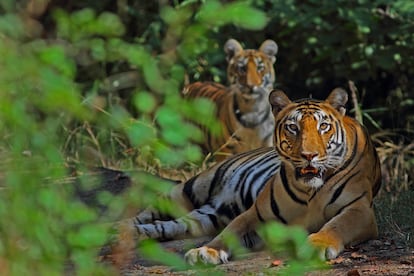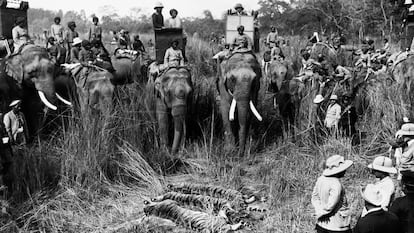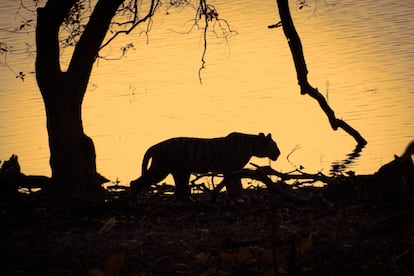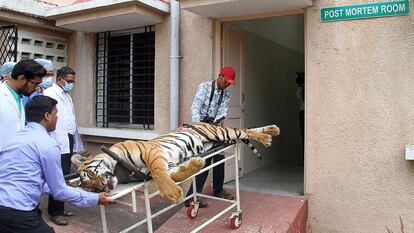Where the tigers roar: A journey through history, myth and geography
In his book ‘The trails of a tiger’ expeditionist José Luis Rivera chronicles his experiences with the felines and discusses what can be done to protect them


In a beautiful new book published by Madrid-based Pérdix Ediciones, renowned expeditionist José Luis Rivera takes readers on a journey through the history, myth and geography of the tiger. The work – titled The trails of a tiger – is filled with photos, maps and drawings, along with thrilling anecdotes from the author, a man who has ample first-hand knowledge of the feline.
Rivera – born in Seville – is a lover of tigers. The 58-year-old tour organizer has trailed after them across the Indian subcontinent, visiting various national parks in Nepal and India. “I’ve been chasing tigers for over two decades. I’ve seen more than 50 in their habitat,” explains Rivera, who directs the Ecowildlife Travel company. A stocky, scruffy fellow, he is full of enthusiasm for his work.
While 50 tigers may not seem like much, it’s actually quite difficult to spot one in person. “Tigers in the wild are solitary, reserved creatures… they’re not like lions, who live in open spaces in the savannah and in large family groups. I’ve managed to see 80 lions in the same day at the Masai Mara reserve in Kenya. Seeing tigers, on the other hand, is very difficult: you have to look for them a lot. If you’re lucky, you’ll find them one out of every three times you go after them.”
It is estimated there are about 22,000 lions left in the wild. But, as Rivera points out, there are only 3,900 tigers left. 90% of them reside in India.

Rivera has no doubt in his mind about which feline is king.
“The tiger, for sure. They’re bigger [than lions]... when they get into a fight, a tiger will always win. A male lion weighs between 550 and 600 pounds – a tiger weighs about 900 pounds.”
When asked what makes us so fascinated by tigers, the expeditionist offers a swift response: “Their mystique. When you see one, you never forget it. When a tiger appears on the scene, the jungle falls silent. The majesty of a tiger is magical.”
The first time Rivera ever saw a tiger was in the Indian state of Bengal in 1998, in the Bandhavgarh National Park. It was a cold November morning – everything was quiet. “Probably a tiger,” a ranger murmured, noting the suddenly stillness of their surroundings. And then, as if on cue, the great beast emerged.
“We felt how some branches parted… when we looked, our blood ran cold. Barely five meters from the car, as if sprung from the very bowels of the forest, a beautiful tiger looked at us. He sniffed the air for a moment and continued walking. He was hunting.”
The prologue of The trails of a tiger is written by Amit Sankhala, one of the world’s foremost tiger experts. The grandson of Kailash Sankhala – the man who founded the Tiger Project in 1973 – opens the book by tracing the feline’s evolution and ancestors, going back to the vicious saber-toothed tiger. He mentions other extinct subspecies of tiger – such as the Caspian and Javan tigers – which were wiped out by the 1970s. He also discusses the Bengal tiger, the most common remaining subspecies, and the Sumatran tiger, of which there are a mere 30 or so left in the South of China.

In the book, which also observes the people and customs of India in a very personal chronicle, the author recalls his trips to the Sevillian countryside with his grandfather, Salvador, who once worked for the famed British hunter, Jim Corbett. Salvador would tell his grandson stories about Corbett’s escapades: “Corbett hunted down 19 tigers and 14 leopards that were putting local populations at great risk… more than 1,300 people had been killed [by tigers and leopards] in Nepal and in the Indian district of Kumaon during Corbett’s time,” says Rivera.
Corbett – who was born in British India in 1875 – was frequently called upon by the state governments in Uttar Pradesh and Uttarakhand to kill man-eating tigers and leopards, who were preying on villagers. In his book, Man-Eaters of Kumaon, Corbett detailed his experiences in the Kumaon-Garhwal regions from 1910 until the 1930s. He passed away in 1955, after establishing India’s first national park in the Kumaon Hills.
Rivera grew up fascinated with Corbett, a man who lived among the rural poor of India for most of his life. During his hunting years in the British Raj, there were more than 300,000 tigers. While Corbett only tracked creatures that were killing human beings, others – both British officials and Indian maharajas – often went hunting for sport. These unnecessary, inhumane hunts devastated the tiger population, causing it to shrink to fewer than 40,000 around the time of Indian independence in 1947.
A bigger scare came in 1972, when then-Prime Minister Indira Gandhi ordered a tiger census. It was found that there were only 1,800 tigers left in the country; they were on the verge of extinction. This is when efforts began to protect and recover the tiger population – a series of projects that are well-documented in Rivera’s book.
As India’s tigers had lost much of their territory to farming, industrialization and human population growth, the key solution was to protect them by creating national parks, a policy that over the last 50 years has allowed for a 70% increase in India’s tiger population. Unfortunately, it has sometimes come at the cost of transferring entire villages out of protected areas.

Rivera devotes some time to the British author, Rudyard Kipling, who authored the 1894 short-story collection Jungle Book, which inspired the classic Disney movie 70 years later. The main antagonist in this literary work was Shere Khan – a tiger.
“[Kipling’s] creation makes me sick… a fattened tiger, a cannibal. But you have to remember that [Shere Khan] has a physical defect, which prevents him from hunting his natural prey and reduces him to feeding on humans and other tigers. The villainy of the tiger established by Kipling is a concept foreign to the Indian mentality, even in the case of man-eating tigers. Most Indians see the tiger as a powerful being of the jungle.”
Shere Khan, it must be remembered, shared the sad fate of so many of his fellow tigers: ultimately killed, he is skinned and turned into a carpet.
The most moving parts of Rivera’s book – which also includes encounters with elephants, leopards, wolves and sloth bears – are the chronicles of his tiger sightings. There is Maya, the queen of Tadoba Andhari; Choti Tara and her cubs, whom the author was able to observe while the mother was nursing them; Krishna, playing with his grown cubs; even the famous Machhli, the queen of tigers, who once battled a crocodile.
On several occasions, Rivera came face-to-face with Ustad, the man-eating tiger whom he later visited when he was imprisoned in the Sajjangarh zoo in Ranthambore National Park. Ustad lived among rats, gnawing on bones, after having been the king of a territory as large as the island of Manhattan.

Rivera discusses the ongoing debate in India regarding the conflicting rights of tigers and humans: 70% of the world’s tigers live in the country, but they are confined to less than 25% of the territory. On occasion, tigers also kill people – about 40 or 50 Indians die each year as a result of tiger attacks. This usually occurs in rural areas, when humans enter the tigers’ domain to collect firewood, relieve themselves or take their cattle to graze.
Ustad, for instance, was responsible for at least four deaths while living on the reserve. At first, his actions were unconfirmed. And, as he was a big tourist attraction, nothing was done… until 2015, when he was literally caught dragging the corpse of Rampal Saini, a 56-year-old forest ranger, with his jaws. Ustad was subsequently captured and transported to a zoo.
Rivera and many tiger experts agree that, when a tiger starts hunting humans, they must be eliminated because when a tiger starts eating people, they rarely stop.
“When [tigers] kill people, you shouldn’t think about it… killing a tiger is the best solution. You can’t translocate it, releasing it somewhere else: that’s irresponsible. And locking a tiger up is cruel. Ustad died last year, after living in terrible conditions.”

Rivera attributes the increasingly high salinity of water in tigers’ habitats – which makes them more aggressive – and the lack of dry land near rivers to be causing them to lash out against humans. As a result of climate change, they have to compete for space and resources. Each year, fishermen and honey collectors go deeper and deeper into the tigers’ natural habitat.
The expeditionist hopes that, with a bit of money and caution, it will be possible to save tigers and people at the same time. His book applauds initiatives that involve communities who live in tiger zones, helping them administer the areas and protect the felines, while simultaneously benefiting from ecotourism.
Despite all the conservation problems and the difficulty of coexistence with humans, Rivera believes that the tiger – so ingrained in our culture – has a guaranteed future.
Tu suscripción se está usando en otro dispositivo
¿Quieres añadir otro usuario a tu suscripción?
Si continúas leyendo en este dispositivo, no se podrá leer en el otro.
FlechaTu suscripción se está usando en otro dispositivo y solo puedes acceder a EL PAÍS desde un dispositivo a la vez.
Si quieres compartir tu cuenta, cambia tu suscripción a la modalidad Premium, así podrás añadir otro usuario. Cada uno accederá con su propia cuenta de email, lo que os permitirá personalizar vuestra experiencia en EL PAÍS.
¿Tienes una suscripción de empresa? Accede aquí para contratar más cuentas.
En el caso de no saber quién está usando tu cuenta, te recomendamos cambiar tu contraseña aquí.
Si decides continuar compartiendo tu cuenta, este mensaje se mostrará en tu dispositivo y en el de la otra persona que está usando tu cuenta de forma indefinida, afectando a tu experiencia de lectura. Puedes consultar aquí los términos y condiciones de la suscripción digital.
More information
Archived In
Últimas noticias
Most viewed
- Reinhard Genzel, Nobel laureate in physics: ‘One-minute videos will never give you the truth’
- Oona Chaplin: ‘I told James Cameron that I was living in a treehouse and starting a permaculture project with a friend’
- Pablo Escobar’s hippos: A serious environmental problem, 40 years on
- Why we lost the habit of sleeping in two segments and how that changed our sense of time
- Chevy Chase, the beloved comedian who was a monster off camera: ‘Not everyone hated him, just the people who’ve worked with him’










































